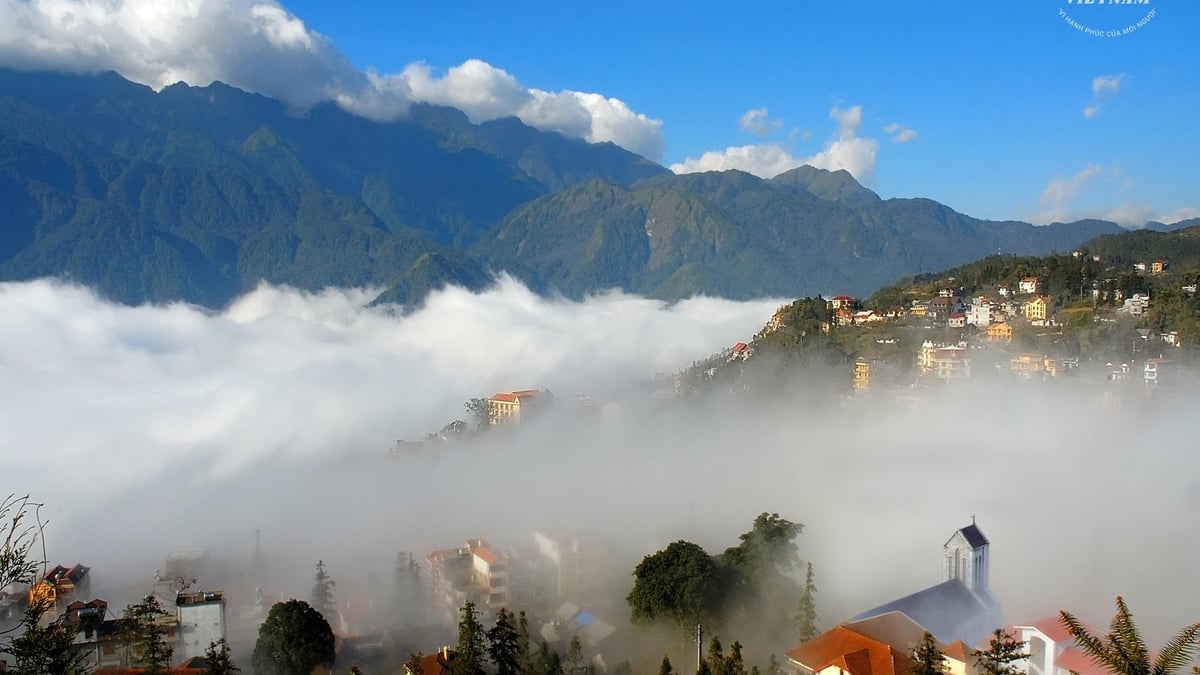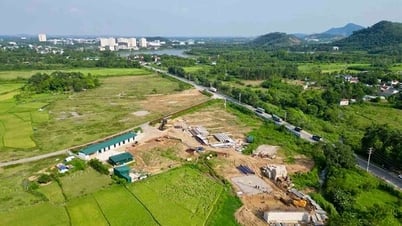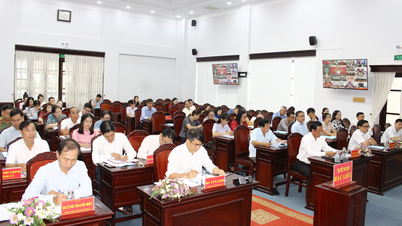Accordingly, the El Nino phenomenon is gradually weakening and is forecast to potentially transition to La Nina in the last months of 2024. Climate change continues to increase extremes (including both lows and highs), so 2024 is forecast to have complex hydrometeorological disasters, including heat waves, drought, salinity, thunderstorms and hailstorms above normal levels in the first half of the year and more rain, storms, floods and inundations, concentrated in the second half of the year. This is an impact scenario similar to the ENSO pattern in 2020.

72 hailstorms since the beginning of the year
Speaking at the Conference, Mr. Hoang Duc Cuong said that El Nino has affected the weather and climate of our country since 2023. This year, the whole country has experienced 8 storms and tropical depressions (5 storms and 3 tropical depressions), 25 cold spells, 20 widespread heat waves, water shortages occurred in the Northern region from January to July 2023, generally 10 - 80% lower than the average; 21 widespread heavy rains, 13 floods in the Northern, Central and Central Highlands regions.
Flash floods and landslides occurred in 35 provinces in the midland and mountainous areas of the Northern, Central and Central Highlands provinces. In addition, many other types of natural disasters have been and are developing complicatedly such as thunderstorms, lightning, fog, hail, cold spells, etc., causing significant damage to people and property, affecting production and people's lives.

By 2024, the average temperature in the first 4 months of the year in all regions across the country will be 0.5 - 1.5 degrees Celsius higher than the average. Particularly in April 2024, in the Northern and North Central regions, the temperature will be 3.1 - 3.6 degrees Celsius higher.
In addition, 110/186 monitoring stations nationwide recorded the highest daily temperature value exceeding the historical value. Notably, in Dong Ha (Quang Tri), the temperature on April 28, 2024 was measured at 44 degrees Celsius, the highest value since 1976 in Quang Tri. The Central Highlands and the South also experienced heat waves and severe heat waves lasting for a long time in April 2024.
In the first months of 2024, there have been many thunderstorms with hail. As of May 7, there have been 72 hailstorms nationwide, of which Nghe An province is the province with the most hailstorms in the country with 11/72 hailstorms; hailstorms, tornadoes, lightning and strong gusts of wind have caused a lot of economic, social and environmental damage.
Flows on rivers and reservoirs in the Northern region are generally 30-60% below average, with a large shortage on Thao and Lo rivers of 50-60%, and flows on rivers in the Central region and Central Highlands are generally 25-50% below average.
Saltwater intrusion in the Southern region in the dry season of 2023-2024 has come earlier and more severe than the average of 2022-2023. The recent saltwater intrusion has caused a local shortage of fresh water in some areas that do not have access to centralized water supplies in some coastal provinces.
Proactive forecasting, early warning and long term
In response to the assessment that El Nino could cause complex natural disasters, the Ministry of Natural Resources and Environment has directed the General Department of Hydrometeorology to closely monitor and supervise natural disasters and water resources in river basins. From there, proactively forecast and warn early and long-term about El Nino, heat waves, droughts, water resources and provide timely information to the commanding agencies and the people.

Deputy Director General Hoang Duc Cuong said that at the beginning of 2023, the Ministry of Natural Resources and Environment issued a Plan to respond to the risk of heat, drought, water shortage, and saltwater intrusion in 2023-2024, clearly assigning tasks to agencies and units to strengthen coordination in the process of organizing and monitoring the situation of heat, drought, water shortage, and saltwater intrusion; closely monitoring the water situation at irrigation and hydropower reservoirs, updating water source forecast bulletins to serve reservoir operations as soon as abnormal conditions are detected.
In the last months of 2023 and early 2024, assessing the complicated developments of natural disasters, the Ministry of Natural Resources and Environment proactively sent official dispatches to the Ministries of Agriculture and Rural Development, Industry and Trade, Transport, etc. and the People's Committees of provinces and centrally-run cities, providing information warning that widespread heavy rains, especially heavy rains, will occur more frequently, causing a high risk of flash floods and landslides in mountainous areas of the Central region and Central Highlands.
On September 22, 2023, the General Department of Hydrometeorology coordinated with the People's Committee of Ben Tre province to organize a conference on forecasting El Nino, water resources, and salinity in the 2023-2024 dry season in the Southern region. Localities in the Southern region have proactively responded and reduced many damages.

In the first months of 2024, the General Department of Hydrometeorology has continuously updated periodic and specialized disaster forecasts and warnings on drought, saltwater intrusion, heat waves, and water shortages to serve command and control agencies and provide information for people to proactively prevent.
In addition, implementing the direction of the Prime Minister, the Ministry of Natural Resources and Environment organized a delegation to survey some key areas of landslides in Dak Nong and Lam Dong provinces. The Ministry reported to the Prime Minister on the causes and proposed some solutions to prevent and combat landslides in the area.
Natural disaster trends from now until the end of the year
Mr. Hoang Duc Cuong said that currently, the El Nino phenomenon is gradually weakening and turning into a neutral state. It is forecasted that it will likely turn into a La Nina state in the last months of 2024.
In the immediate future, the North and Central provinces are likely to experience two heat waves and widespread severe heat waves in the second half of May. The Central Highlands and the South may experience one heat wave in the coming days and there will be seasonal rains in the second half of May, the heat will gradually decrease.

From June to the end of 2024, heat waves will increase in intensity and gradually expand to other areas of the Northern region, the North Central region and the Central Central region. Heat waves and severe heat waves are likely to appear more frequently than the average in July - August 2024, with precautions against particularly severe heat waves. Heat waves tend to decrease gradually from the second half of August in the Northern region and from September in the Central region.
The Central region is also likely to experience prolonged drought during the period from May to August 2024, concentrated in the provinces from Quang Tri to Binh Thuan.
Regarding storms and tropical depressions, there are forecasts of about 11-13 storms in the East Sea and 5-7 storms affecting the mainland. Storm and tropical depression activities are likely to concentrate in the second half of the storm season (from September to November 2024).
Heavy rain is forecast to appear mainly in the North from July to September, and in the Central region from September to November. Localized heavy rain with high intensity from 50-100mm in 3-6 hours is likely to appear frequently in the coming time, beware of landslides and flash floods in mountainous areas, and urban flooding.
In particular, the La Nina scenario warning in the second half of 2024 may cause concentrated rains in the last months of 2024 in the Central region.
The Southeastern coast is forecasted to have 3 high tides, on September 18-23, October 16-22, November 12-20 and December 12-18. Of which, on October 16-22 and November 12-20, the water level at Vung Tau station may reach over 4.3m. There is a high risk of flooding in low-lying areas and areas outside the dyke, especially when it coincides with the strong monsoon winds in the area. In July-August 2024, the coast of the Southwestern provinces is likely to experience 1-2 unusual sea level rises accompanied by large waves causing sea dyke erosion, especially in Tran Van Thoi district, Ca Mau.
In the first half of the rainy season, natural disasters will be concentrated in the North, North Central, and Central Highlands, and with the La Nina scenario, storms will be concentrated in the last period of the year.
More storms form in the East Sea and impact land more quickly in the second half of the year. Heavy rains, storms, flooding and the risk of flash floods and landslides in the Central region in the second half of 2024 show signs similar to the 2020 storm season.
Deputy Director General of the General Department of Hydrometeorology Hoang Duc Cuong
According to Deputy Director General Hoang Duc Cuong, in the coming time, the Ministry of Natural Resources and Environment will direct its affiliated units to closely monitor weather, hydrology, and oceanography nationwide; apply new technology to detail and transmit forecast information; maintain and develop forms of transmitting meteorological and hydrological forecasts and warnings to users such as applications on mobile phones, Facebook, Zalo, Youtube, etc.
In addition, review and adjust inter-reservoir operating procedures, including recommendations to amend a number of articles on a number of river basins to address existing problems and inadequacies and to be flexible in adapting to climate change, ensuring harmony in water storage for electricity production and downstream water supply.
Source: https://baotainguyenmoitruong.vn/bien-doi-khi-hau-lam-gia-tang-tinh-cuc-doan-cua-thien-tai-nam-2024-373998.html
































![[Photo] Prime Minister Pham Minh Chinh works with the Standing Committee of Thai Binh Provincial Party Committee](https://vphoto.vietnam.vn/thumb/1200x675/vietnam/resource/IMAGE/2025/5/12/f514ab990c544e05a446f77bba59c7d1)

![[Photo] Prime Minister Pham Minh Chinh receives Swedish Minister of International Development Cooperation and Foreign Trade](https://vphoto.vietnam.vn/thumb/1200x675/vietnam/resource/IMAGE/2025/5/12/ae50d0bb57584fd1bbe1cd77d9ad6d97)



































































Comment (0)